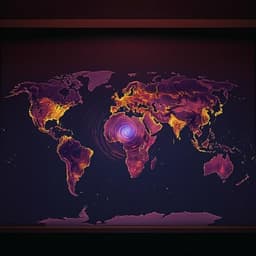
Environmental Studies and Forestry
Fire deficit increases wildfire risk for many communities in the Canadian boreal forest
M. Parisien, Q. E. Barber, et al.
Explore how decades of fire suppression in Canada's boreal forest may be backfiring, leading to increased wildfire risks near communities. This research, conducted by Marc-André Parisien and his colleagues, uncovers alarming trends showing a significant fire deficit in many areas.
Playback language: English
Introduction
Over the past 50 years, Canada has seen an increase in annual area burned, particularly in the west. Wildfires are complex, influenced by climate change, fuel composition, land use, and fire management. Population growth in fire-prone areas, coupled with climate change projections, exacerbates the risk to human life and property. While fire suppression is a priority in Canada, its long-term effects on boreal burn rates remain unclear. Although humans cause over half of ignitions, suppression activities (early detection and rapid attack) have decreased the area burned. This suppression may create a wildfire deficit, increasing flammable biomass, especially near communities. The North American boreal forest experiences a mix of small fires and infrequent, large, high-intensity crown fires. Forests less than 30 years old (recently burned forests, RBF) are less flammable due to biomass depletion and slow regrowth. This negative feedback between fire and fuel is crucial. Canadian fire management zones are categorized as 'intensive' (aggressive suppression near communities and resources) and 'extensive' (monitoring with minimal intervention unless human values are at risk). Public safety and community protection are prioritized regardless of the zone. Decades of aggressive suppression around communities may have altered the forest mosaic by promoting older, more flammable stands. This study analyzes the potential flammability of forest cover surrounding communities compared to the broader landscape, focusing on the proportion of RBF within concentric rings (up to 25 km) around communities and comparing it to the RBF percentage in similar fire regime zones (FRZ).
Literature Review
The authors cite several studies examining fire regime changes in Canada (Hanes et al., 2019; Kasischke & Turetsky, 2006), the influence of climate change on wildfires (Flannigan et al., 2006; Xi et al., 2019), mapping of wildland fire interface areas (Johnston & Flannigan, 2017), and future area burned projections (Flannigan et al., 2005; Wotton et al., 2017). They also reference work on the spatially varying influence of humans on fire probability (Parisien et al., 2016), large forest fires in Canada (Stocks et al., 2002), effective fire suppression in boreal forests (Cumming, 2005), the impact of fire suppression on area burned (Martell & Sun, 2008), the effects of fire suppression on landscape structure (Baker, 1994), and the wildfire deficit and surplus in the western United States (Parks et al., 2015). Studies on fuel accumulation in boreal wildfire regimes (Thompson et al., 2017), the resistance of the boreal forest to high burn rates (Héon et al., 2014), the influence of time since prior wildfire on fire containment (Beverly, 2017), and mapping local effects of forest properties on fire risk (Bernier et al., 2016) are also reviewed. Additional references cover forest resilience to changing fire frequency (Hart et al., 2018), vegetation feedbacks limiting fire regime responses to global warming (Marchal et al., 2020), changes in mean forest age (Boulanger et al., 2017), and spatial and temporal dimensions of fire activity (Erni et al., 2017). The authors also reference studies on forest fire management in Canada (Stocks & Simard, 1993; Magnussen & Taylor, 2012), the evaluation of fire initial attack resources (Martell et al., 1984), wildfire management in Canada (Tymstra et al., 2020), temporal patterns of wildfire activity (Campos-Ruiz et al., 2018), and the impact of fire suppression on forest mosaic (Cui & Perera, 2008). Finally, they cite studies on initial attack fire crew productivity and effectiveness (Hirsch & Martell, 1996), wildfires, complexity, and highly optimized tolerance (Moritz et al., 2005), attribution of extreme fire risk to human emissions (Kirchmeier-Young et al., 2017), the potential spread of wildfires (Wang et al., 2014), fire suppression costs under climate change (Hope et al., 2016), and the initial attack fire crew effectiveness (Hirsch et al., 1998). The "fire paradox" (Arno & Brown, 1991) and negative consequences of positive feedbacks in wildfire management (Calkin et al., 2015) are also discussed, along with studies about reburns and research needs (Prichard et al., 2017), the influence of stand age on wildfire ignition and spread (Erni et al., 2018), effects of lakes on wildfire activity (Nielsen et al., 2016), prevalence rates of anxiety disorders after wildfires (Agyapong et al., 2018), the mediation of reburning likelihood by climate variation and drought (Parks et al., 2018), the influence of weather, fuels, and topography on wildfire spread (Holsinger et al., 2016), and an assessment of surface and atmospheric conditions associated with extreme wildfire seasons (Kochtubajda et al., 2019). Fire prevention education (Prestemon et al., 2010), risk management to prevent wildfire disasters (Calkin et al., 2014), fire-smart forest management (Hirsch et al., 2001), integrating biophysical and eco-cultural fire processes (White et al., 2011), the science of firescapes (Smith et al., 2016), fire, climate change, carbon, and fuel management (Amiro et al., 2001), the theory and practice of wildland fuels management (Omi, 2015), a climate solution for the boreal forest (Astrup et al., 2018), prescribed fire in North American forests (Ryan et al., 2013), temperate and boreal forest mega-fires (Stephens et al., 2014), and a more holistic approach to wildland fire management (Tymstra et al., 2020) are also discussed.
Methodology
The study area encompassed the entire boreal region of Canada, subdivided into 12 fire regime zones (FRZ) based on similar fire regimes. From an initial dataset of 381 boreal communities, 160 were selected based on population size (>200), forest cover within a 25-km buffer (>70%), and spatial separation to avoid overlap in analysis. The National Burned Area Composite was used to analyze wildfire patterns and calculate time since fire, creating a map of recently burned forests (RBF, <30 years old). Permanent nonfuels (water, tundra, rock) were masked. Concentric 5-km buffers (up to 25 km radius) were created around community boundaries to analyze RBF percentages. Overlapping buffers were adjusted to prevent interaction among neighboring communities. Pixels within 2 km of community boundaries were removed to account for local factors. The RBF percentages in these buffers were compared to the RBF percentages of the corresponding FRZ. A sensitivity analysis was performed using 20 and 40-year thresholds for RBF to assess robustness. Supplementary analyses investigated the influence of other factors: ignition density (within 5-km buffers compared to areas beyond), forest harvest percentage (1985-2015), and land cover (water, permanent nonfuel, deciduous forest). Ignition density was calculated using data from fires larger than 0.1 ha (1988-2017). Forest harvest data were obtained from a Canada-wide Landsat-based dataset (1985-2015). Land cover data were from the Canada MODIS Land Cover Time Series (2000-2011) and the National Risk Analysis Fuel map (250-m resolution). All analyses were conducted using R software and ArcGIS.
Key Findings
The study revealed a low percentage of RBF around most communities. A significant fire deficit (lower RBF percentage around communities than in their corresponding FRZ) was observed in several FRZs, especially those with high burn rates. Communities in FRZs 5 and 11 showed statistically significantly lower RBF percentages at all distances (5-km buffers) compared to their FRZs. This was also true for communities in other FRZs at specific distances. The cumulative effect of the fire deficit was substantial among concentric rings. A majority (74.4%) of communities were surrounded by older forests (≤10% RBF) within a 10-km radius. Relativized to FRZ mean values, 54.4% of communities exhibited a fire deficit (≥5% RBF difference from the FRZ), 15% a surplus, and the remainder showed no substantial difference. Analysis of other factors (water, deciduous forests, permanent nonfuels, logging) did not strongly correlate with RBF percentages around communities. Four case studies of recent large wildfires (Eastmain, QC 2013; La Ronge, SK 2015; Fort McMurray, AB 2016; Whatì, NT 2015) showed significantly lower pre-fire RBF percentages around communities compared to their FRZs, indicating a fire deficit before the wildfires. The wildfires themselves largely or entirely eliminated this deficit. Ignitions were 21.6 times higher within 5 km of communities than beyond, and 62.3 times higher for human-caused ignitions. The sensitivity analysis showed that the results were robust to changes in the RBF age threshold (20 or 40 years).
Discussion
The findings highlight the "fire paradox", where successful fire suppression, without fuel management, leads to a fire deficit and increased risk. The lack of RBF near many communities, particularly in western Canada and high burn rate FRZs, increases the risk of fast-spreading, high-intensity wildfires that are difficult to control. The 2016 Fort McMurray wildfire serves as a prime example. While a low RBF percentage doesn’t always indicate high wildfire exposure (e.g., communities near large water bodies in eastern Canada), the study's results suggest this isn't generally the case. The high ignition density near communities, coupled with continuous older forests, could lead to increased calls for fire suppression, exacerbating the issue. Therefore, a comprehensive approach is needed, combining efficient fire suppression with proactive mitigation strategies.
Conclusion
This research demonstrates a fire deficit around many Canadian boreal communities due to decades of fire suppression, increasing wildfire risk. Proactive mitigation strategies, such as enhanced fire prevention, reducing ignition potential of structures, targeted fuel management, and prescribed burning, are crucial. While challenges exist (cost, scale, ecological considerations), integrating these approaches with efficient fire suppression is essential for reducing wildfire risk to communities. Further research should focus on determining the critical proportion of RBF necessary for substantial risk reduction and investigating alternative fuel management strategies, like promoting deciduous stands.
Limitations
The study's selection criteria for communities might have introduced bias. While efforts were made to control for confounding factors like proximity to water bodies, other unmeasured variables could have influenced the results. The analysis relies on existing data sets with inherent limitations in spatial resolution and accuracy. Future studies could benefit from finer-scale data and more comprehensive modeling to assess risk more accurately.
Related Publications
Explore these studies to deepen your understanding of the subject.







